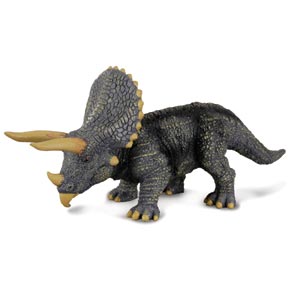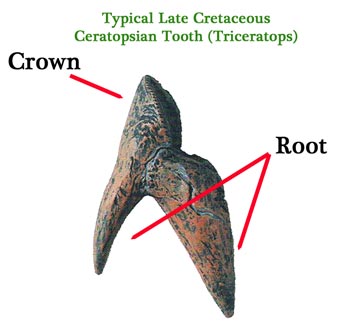Japan’s First Horned Dinosaur – A Remarkable Discovery
Fossil Tooth Provides Link Between Ceratopsians and Japan
Several Japanese news agencies have reported the discovery of a single, fossilised tooth of an ornithischian dinosaur in Japan. The fossil tooth which comprises of a dental root joint is very distinctive. It has been identified as the tooth of a member of the Ceratopsia more specifically, it bares a close resemblance to a member of the Ceratopsidae (horned dinosaurs), a later and more advanced group of horned dinosaurs that include the likes of Triceratops, Styracosaurus and Chasmosaurus.
Did Japan Have its Own Version of Triceratops?
Picture credit: Everything Dinosaur
For models and replicas of articulated horned dinosaurs, take a look at the Beasts of the Mesozoic range of figures: Beasts of the Mesozoic Figures and Models.
Horned Dinosaurs
It is thought that the horned dinosaurs, part of the ornithischian group of the Dinosauria, evolved in Asia during the Cretaceous geological period. For much of the Cretaceous, the land that we now know as Japan was underwater, that which was above sea level was not part of an island chain, but attached to the landmass that was to become Asia. The numerous known genera of Japanese Cretaceous dinosaurs therefore have a strong affinity with Asian dinosaurs. Evidence of hadrosaurs, sauropods and meat-eating theropod dinosaurs have been found in Japan, but this is only the second time fossils of a member of the Ceratopsia have been found and this new discovery represents a more advanced and later type of horned dinosaur.
To read about the discovery of a huge dinosaur thigh bone in Japan: Huge Sauropod Femur Discovered in Japan.
Japan’s Second Dinosaur Fossil Find
A spokesperson from the National Museum of Nature and Science in Tokyo commented that this was only Japan’s second fossil find that represents a member of the Ceratopsia. The first fossil discovery, that of a dinosaur regarded as a member of the Neoceratopsia was found in the Hyogo Prefecture region of Japan (Honshu island). Fossils of neoceratopsian dinosaurs have been found in China and Mongolia.
The fossil measures 1.21 centimetres in length and is 0.37 centimetres wide. It was found back in November 2011 during a geological survey of Campanian faunal strata on Shimo-koshiki Island (western tip of the main Japanese island chain). The fossil is believed to be around 80 million years old (Late Cretaceous), a time when the giant horned dinosaurs roamed North America. A detailed paper on this tooth discovery and its implications in terms of ceratopsian evolution and radiation will be presented at the June meeting of the Palaeontological Society of Japan to be held in Kumamoto Prefecture.
Late Cretaceous Ceratopsians
The jaws of Late Cretaceous ceratopsians, dinosaurs such as the famous Triceratops, Pachyrhinosaurus and Styracosaurus were lined with many hundreds of teeth. These teeth were strongly anchored to the jawbone by a “Y” shaped root structure. The ceratopsians are the only dinosaurs to have this “Y” shaped dental root structure, in essence, to have two dental roots per tooth. The actual crown of the tooth (the part of the tooth that sticks up from the jawline), was a square and blocky shape, ideal for crushing and grinding up tough vegetation. It is likely that at the front of the mouth of this new Japanese ceratopsian there was a strong beak. The beak was used to break off plant material before the strong and muscular tongue pushed the plant material further back into the jaws where the teeth could do their work, reducing the plant debris to pulp before it was swallowed.
An Illustration of a Tooth of a Typical Late Cretaceous Horned Dinosaur (Triceratops)
Picture credit: Everything Dinosaur
The tooth has been described as closely matching that of the Late Cretaceous North American member of the Chasmosaurinae ceratopsians – Triceratops (T. horridus). Although, an adult Triceratops was estimated to have reached lengths in excess of nine metres, the Japanese tooth specimen indicates a much smaller animal, a cow-sized horned dinosaur between two to three metres in length.
Experts judged the length of the dinosaur’s body to be two to three meters or more, based on the size of the dental root. The size estimate was based on the length of the tooth root and comparing this fossil specimen with other ceratopsian tooth fossils from better known Late Cretaceous genera.



